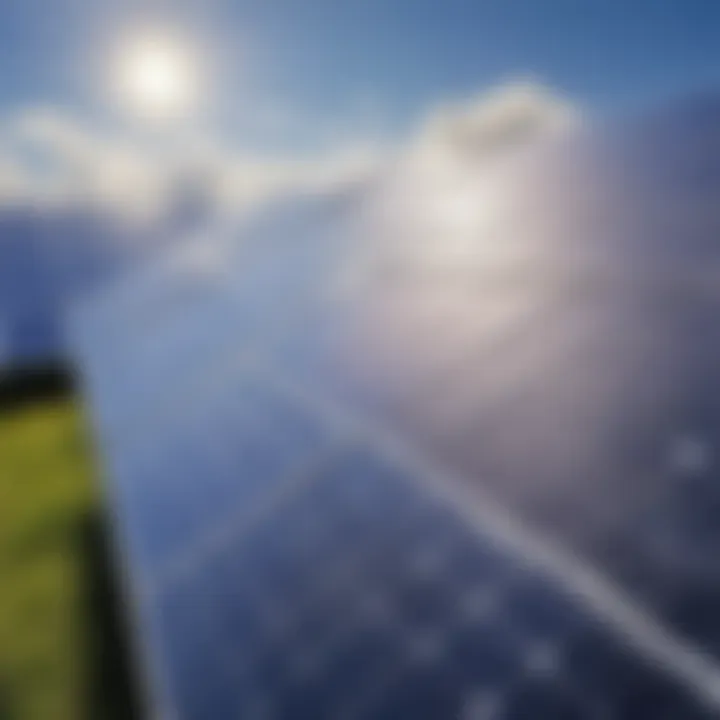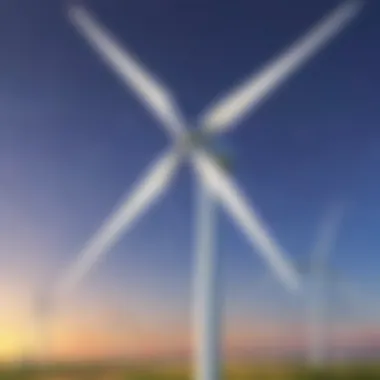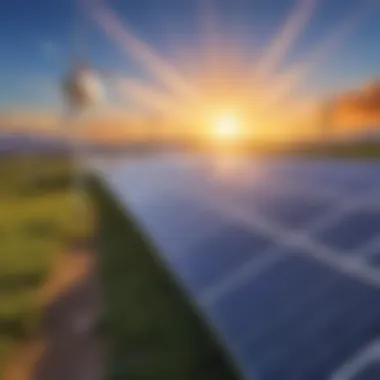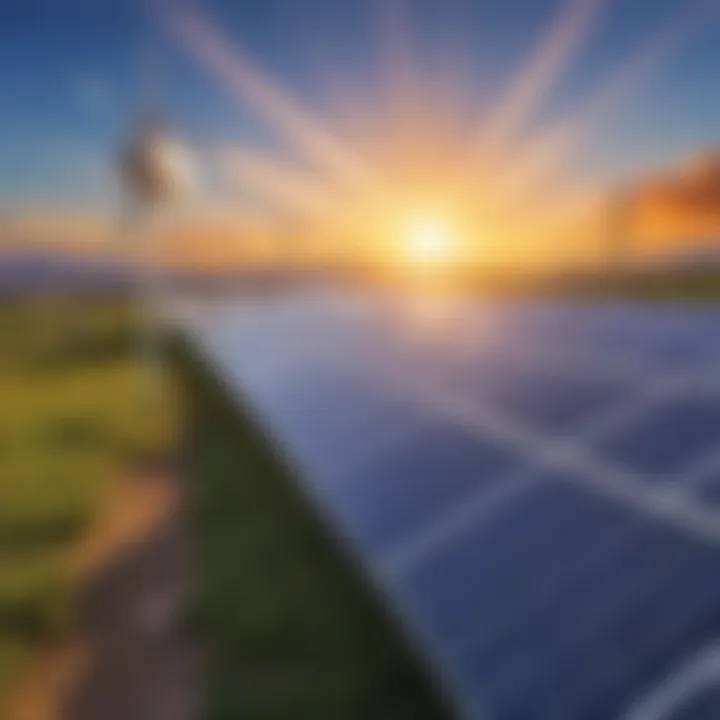Unveiling the Fascinating World of Solar Power and Wind Energy for Young Science Enthusiasts


Science Fun Facts
Have you ever wondered how the sun's energy can be turned into electricity or how the wind can power entire cities? Renewable energy sources like solar power and wind energy hold the key to a greener and more sustainable future for our planet. Let's explore some fascinating trivia and facts about these innovative technologies that are shaping the way we generate electricity.
- Did you know that the energy from the sun that reaches the Earth in just one hour is enough to meet the entire world's energy needs for a whole year? That's the power of solar energy!
- In windy regions, wind turbines can harness the power of the wind to generate electricity, helping to reduce our reliance on fossil fuels and combat climate change.
Discover the Wonders of Science
In our journey of exploring renewable energy sources, we will delve into the scientific concepts behind solar power and wind energy. Through educational videos, animations, and interactive learning tools, we will unravel the mysteries of how these technologies work and their real-world applications. Join us as we discover the wonders of science and how it can shape a more sustainable future for generations to come.
- Educational videos will illustrate how solar panels convert sunlight into electrical power, offering a visually engaging way to understand this complex process.
- Interactive animations will showcase the inner workings of wind turbines, shedding light on the mechanics behind harnessing wind energy for electricity production.
- Real-life examples will demonstrate how countries around the world are adopting renewable energy solutions to reduce carbon emissions and combat climate change.
Science Quiz Time
Are you ready to test your knowledge on solar power and wind energy? Engage in interactive quizzes, solve brain teasers, and explore thought-provoking questions related to renewable energy sources. Through gamification and multiple-choice questions, you will deepen your understanding of how these technologies are revolutionizing the energy sector and paving the way for a greener tomorrow.
- How many solar panels would it take to power an entire household for a year? Test your mathematical skills and uncover the answer to this intriguing question!
- Brain teasers will challenge you to think critically about the environmental benefits of renewable energy and why it is essential for a sustainable future.
Science Experiment Showcase
Get ready for some hands-on fun with science experiments showcasing the principles of solar power and wind energy. With step-by-step instructions, a materials list, and safety tips, you can conduct your own experiments at home and witness the power of renewable energy firsthand. Let's dive into the world of scientific exploration and uncover the magic behind solar panels and wind turbines.
- Follow the detailed instructions to build a mini solar-powered car and see how sunlight can be transformed into motion.
- Learn about the different components of a wind turbine by creating a simplified model using everyday materials found in your home.
- Safety tips will guide you on how to handle materials and tools responsibly, ensuring a fun and risk-free science experiment experience.
Introduction


Renewable energy is a topic of immense significance in today's world, shaping the future of energy production and environmental sustainability. Understanding the concept of renewable energy is crucial for young science enthusiasts keen on exploring innovative solutions to global challenges. As fossil fuel reserves diminish and concerns about climate change escalate, the shift towards renewable energy sources like solar power and wind energy becomes increasingly vital. This article serves as a gateway for young minds to delve into the fascinating realm of renewable energy, offering insights into how these sources work and their role in safeguarding the planet's future. By grasping the foundations of renewable energy, children can cultivate a profound appreciation for clean energy technologies and their potential to revolutionize the way we power our world.
Understanding Renewable Energy
Renewable energy is an essential topic that holds significant relevance in today's world, especially concerning sustainability and environmental conservation. This article aims to shed light on the various aspects of renewable energy sources and their crucial role in shaping a greener future. By delving into the concepts of renewable energy, we can gain a deeper understanding of how these resources offer a viable alternative to traditional fossil fuels, which play a pivotal role in combating climate change and reducing carbon emissions.
Definition of Renewable Energy
Renewable energy is derived from natural resources such as sunlight, wind, and water that are naturally replenished. Unlike fossil fuels, which are finite and contribute to environmental degradation, renewable energy sources are sustainable and environmentally friendly. The key defining characteristic of renewable energy is its ability to replenish itself over time, making it an inexhaustible source of power for various applications.
Importance of Renewable Energy
The importance of renewable energy cannot be overstated in the current global scenario. As the world grapples with the challenges of climate change and dwindling fossil fuel reserves, renewable energy offers a ray of hope for a sustainable future. By harnessing the power of renewable resources, we can reduce our dependence on non-renewable fuels, mitigate greenhouse gas emissions, and pave the way for a cleaner and more sustainable energy landscape.
Solar Power: Harnessing Energy from the Sun
Solar power, a vital segment of the renewable energy discourse, plays a pivotal role in this exploration. The concept of harnessing energy from the sun opens up a realm of possibilities for sustainable energy production. Understanding how solar power functions is crucial for young science enthusiasts, as it showcases the significant impact that renewable resources can have on our energy landscape. By delving into solar power, readers can grasp the essence of utilizing sunlight as a clean and abundant source of energy.
How Solar Power Works
Explaining the mechanics behind solar power offers a fascinating glimpse into the conversion of sunlight into usable electricity. Solar panels, composed of photovoltaic cells, absorb sunlight and initiate an electron flow, generating direct current (DC) electricity. This electricity is then converted into alternating current (AC) through inverters, making it compatible with household appliances and the power grid. Understanding this process sheds light on the ingenuity required to transform solar energy into a practical power source.
Advantages of Solar Power
The advantages of solar power are vast and multifaceted, providing a compelling case for its adoption. Solar energy is clean and renewable, producing electricity without harmful emissions or by-products, thus contributing to environmental preservation. Additionally, solar panels require minimal maintenance and can be installed on various scales, from individual homes to large-scale solar farms. This accessibility makes solar power a versatile and sustainable energy solution that empowers communities to reduce reliance on fossil fuels.
Challenges of Solar Power


Despite its numerous benefits, solar power also faces challenges that warrant consideration. One significant issue is the intermittency of sunlight, as solar energy generation is dependent on daylight hours and weather conditions. Energy storage technologies, such as batteries, are essential to store excess energy for use during low-light periods. Furthermore, the initial cost of installing solar panels can be a barrier for some, although declining prices and government incentives are helping to make solar power more affordable and widespread. Recognizing and addressing these challenges is crucial for advancing the adoption of solar energy technology.
Wind Energy: Tapping into Wind Power
In this section, we delve into the crucial topic of Wind Energy: Tapping into Wind Power, uncovering its significance in the realm of renewable energy. Wind energy plays a pivotal role in the quest for sustainable power sources, offering a clean and abundant alternative to traditional fossil fuels. It harnesses the natural power of the wind to generate electricity, contributing to reducing greenhouse gas emissions and mitigating climate change. Young science enthusiasts keen on understanding renewable energy must grasp the fundamental mechanics and benefits associated with tapping into wind power.
How Wind Energy is Generated
Exploring how wind energy is generated unveils a fascinating process rooted in harnessing the kinetic energy present in wind. Wind turbines, strategically positioned in areas with high wind speeds, capture the energy from the moving air through their large rotor blades. As the wind turns the blades, the rotor spins a generator, converting kinetic energy into electrical energy. This clean and renewable method of electricity generation showcases the efficiency and environmental friendliness of wind power.
Benefits of Wind Energy
Delving into the benefits of wind energy unravels a myriad of advantages that make it an attractive renewable energy source. Wind power is inexhaustible, with wind being a constantly available resource. It is a clean energy option, producing zero emissions during electricity generation. Additionally, wind farms can be established on various scales, from small individual turbines to large utility-scale installations, offering flexibility in deployment. Understanding and harnessing wind energy as a power source is essential for a sustainable energy future.
Challenges of Wind Energy
Examining the challenges of wind energy brings to light important considerations that accompany its implementation. One major challenge is the intermittency of wind resources, as wind speeds fluctuate and may not always align with electricity demand. Storage solutions and smart grid technologies are being developed to address this issue. Another concern is the impact of wind farms on wildlife and ecosystems, emphasizing the need for proper siting and environmental assessments. Overcoming these challenges is crucial for maximizing the potential of wind power and ensuring its long-term viability in the renewable energy landscape.
Comparing and Contrasting Solar Power and Wind Energy
In this segment of the article, we delve into the intriguing realm of comparing and contrasting two significant renewable energy sources - solar power and wind energy. This comparative analysis plays a pivotal role in providing young science enthusiasts with a nuanced understanding of sustainable energy options
Solar Power vs. Wind Energy: A Detailed Examination
Solar Power: Exploring the utilization of sunlight to generate electricity, solar power stands as a cornerstone in the realm of renewables. Diving deeper, photovoltaic cells convert sunlight into electricity directly, offering a clean and sustainable energy solution. One key aspect worth considering here is the immense potential of solar power in reducing carbon emissions and mitigating climate change effects.
On the other hand, Wind Energy: Harnessing the power of wind to produce electricity, wind energy has garnered attention for its eco-friendly attributes. Wind turbines capture the kinetic energy of the wind and convert it into electrical power, presenting a distinct advantage in areas with consistent wind patterns. However, challenges such as intermittency and dependency on wind strength require strategic planning for optimal utilization.


Benefits and Challenges: Unveiling the Contrasts
When comparing solar power and wind energy, benefits and challenges emerge as crucial discerning factors. Solar power boasts advantages such as low operating costs, minimal maintenance requirements, and scalability for diverse applications. Conversely, challenges like variability in sunlight availability prompt the need for storage solutions and efficient grid integration strategies.
In contrast, wind energy offers benefits like high energy production potential, complemented by established technological advancements. However, challenges such as visual and noise disturbances, as well as bird and bat collision risks, underscore the importance of site selection and environmental impact assessments.
Synthesizing Key Insights
By analyzing the nuances of solar power and wind energy within the context of renewable energy exploration, young science enthusiasts gain a holistic view of sustainable energy alternatives. Understanding the comparatives strengths and limitations of these sources equips them with valuable knowledge to shape informed decisions on future energy endeavors, paving the way for a greener and more sustainable future.
Future Prospects in Renewable Energy
Introduction
As we delve into the realm of renewable energy, it is crucial to look ahead and examine the future prospects in this dynamic field. The significance of exploring future prospects in renewable energy lies in paving the way for a sustainable and greener tomorrow. By understanding the advancements and innovations in renewable energy sources, such as solar power and wind energy, we can grasp the potential benefits they hold for our environment and society.
Technological Advancements
One of the key elements when considering future prospects in renewable energy is the continuous advancement in technology. Engineers and scientists are constantly developing more efficient solar panels and wind turbines to harness energy from natural sources more effectively. These advancements not only increase energy production but also enhance the overall feasibility and reliability of renewable energy systems, making them more accessible for widespread adoption.
Environmental Benefits
Looking towards the future, the environmental benefits of renewable energy sources come into sharper focus. Solar power and wind energy are clean and sustainable alternatives to fossil fuels, emitting no greenhouse gases or harmful pollutants during energy generation. Embracing these sources on a larger scale can significantly reduce carbon emissions and combat climate change, securing a cleaner and healthier environment for future generations.
Economic Considerations
In discussing future prospects, we must also consider the economic aspects of renewable energy. As renewable technologies advance and become more cost-effective, investing in solar and wind power presents not just an environmental solution, but also an economic opportunity. The renewable energy sector offers new job prospects, promotes innovation, and stimulates economic growth through investments in infrastructure and clean energy development.
Conclusion
Conclusion
Renewable energy sources are essential components in the progression towards a sustainable future. In this article, we have explored the significance of solar power and wind energy in shaping our energy landscape. Understanding the importance of these sources not only offers insights into clean energy production but also highlights the critical role they play in mitigating environmental impacts. The transition towards renewable energy sources is imperative in combating climate change and reducing our reliance on finite resources. By embracing solar power and wind energy, we pave the way for a greener and more sustainable world for future generations to thrive in. As young science enthusiasts, it is crucial to grasp the potential of renewable energy sources and their contribution to building a brighter, cleaner tomorrow.







